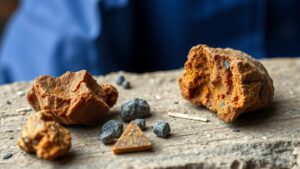How to Interpret Geological Cross-Sections for Ore Body Exploration
How to Interpret Geological Cross-Sections for Ore Body Exploration
Interpreting geological cross-sections is a vital skill in ore body exploration, enabling geologists to visualize subsurface formations. These cross-sections provide insights into the geological history, structure, and potential mineralization of an area, which are essential in locating economically viable ores. This article discusses the key components of geological cross-sections, methodologies to interpret them, and practical implications for ore exploration.
The Basics of Geological Cross-Sections
A geological cross-section is a vertical slice through the Earth that illustrates the arrangement and relationships of geological units. e sections are constructed using a combination of surface mapping, drilling data, and geophysical surveys. In essence, they act like a window into the subsurface geology, allowing geologists to visualize complex three-dimensional structures in a two-dimensional format.
Key Components of Geological Cross-Sections
Understanding the various components of geological cross-sections is crucial for effective interpretation. The essential elements include:
- Stratigraphy: This refers to the layering of rock and soil, which can indicate relative ages and environmental conditions during deposition.
- Structural Features: This includes faults, folds, and intrusions that affect the arrangement and formation of geological units.
- Mineralization Zones: Areas where ore bodies are concentrated, often influenced by the surrounding geology and structure.
- Hydrogeology: The study of water movement in the geological framework, which can impact ore formation and extraction.
Methodologies for Interpreting Cross-Sections
Accurate interpretation of geological cross-sections involves several methodologies, which can be categorized as follows:
- Visual Interpretation: Involves the qualitative assessment of rock types, structural features, and mineralization patterns based on the graphical representation.
- Geostatistical Analysis: Uses statistical methods to analyze spatial patterns of geological data, often to model ore body locations more reliably.
- Geophysical Methods: Techniques such as magnetic, resistivity, and seismic surveys that can provide indirect evidence of subsurface characteristics.
Case Study: The Cadia Valley Operations
The Cadia Valley Operations in Australia is a prime example of how geological cross-sections can guide ore body exploration. Initially, the exploration team used cross-section visualization to identify the stratigraphy and structural controls of mineralization. They discovered complex relationships between volcanic rocks and sedimentary layers, leading to significant gold and copper deposits. In this case, cross-sections assisted geologists in developing a successful mining strategy by revealing multiple ore zones and their orientations.
Practical Implications
Effective interpretation of geological cross-sections directly informs several practical aspects of ore body exploration:
- Resource Estimation: Allows for accurate calculation of the volume of ore deposits, guiding financial investments in mining operations.
- Risk Assessment: Identifying potential geological hazards such as unstable slopes or groundwater issues can mitigate risks during exploration and extraction.
- Exploration Strategies: Understanding geological features can lead to more targeted drilling and geophysical surveys, optimizing exploration efforts.
Actionable Takeaways
For those involved in ore body exploration, the following practical steps can enhance the interpretation of geological cross-sections:
- Invest in training programs focused on geological interpretation to ensure team members are skilled in reading and analyzing cross-sections.
- Use software tools that integrate geospatial data, allowing for advanced modeling and visualization of geological cross-sections.
- Engage in collaborative projects with geophysicists and geostatisticians to build comprehensive models that encompass both geological and statistical insights.
To wrap up, the interpretation of geological cross-sections is a crucial aspect of ore body exploration. By leveraging the principles discussed in this article, geologists can enhance their ability to identify and evaluate ore deposits effectively, ultimately leading to more successful exploration and extraction efforts.


